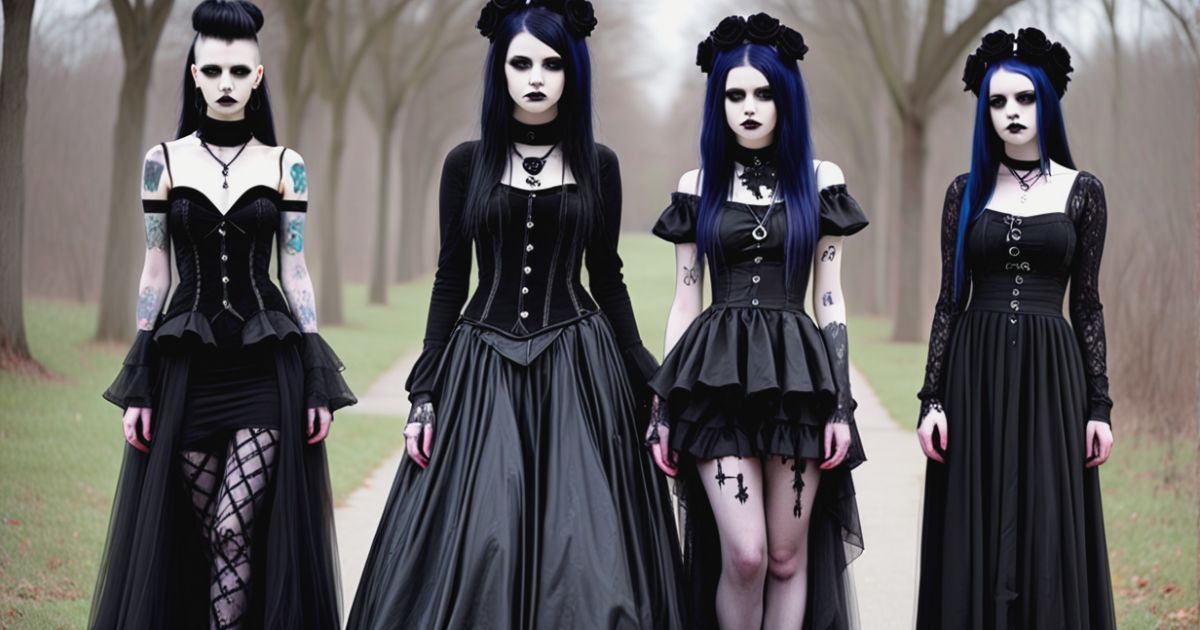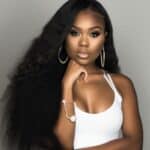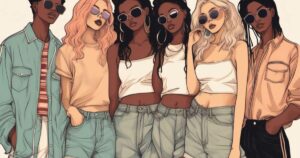Since its emergence in the late 1970s, gothic fashion has evolved into a captivating subculture, continuously morphing and diversifying to accommodate a plethora of styles. From the timeless Victorian-inspired goth to the avant-garde cybergoth, there exists a style to suit every inclination and preference.
Below, we present a comprehensive catalog of various goth styles, each boasting its own unique aesthetic and sartorial components. Whether you lean towards a contemporary, pared-down interpretation of gothic fashion or gravitate towards the nostalgic allure of classic, traditional goth, this list has something to satiate every fashion connoisseur’s appetite.
1. Goth Lolita
Goth Lolita, often abbreviated as GothLoli, stands as a distinguished pillar within the realm of Gothic styles. Melding the charming and feminine allure of Lolita fashion with the darker hues of Gothic influence, it crafts a unique and captivating aesthetic that seamlessly blends Western and Japanese fashion sensibilities.
Defined by its palette of somber tones, intricate lace, delicate ribbons, and nods to the Victorian era, Goth Lolita encapsulates an essence of mystery and elegance. Yet, beyond its outward appearance, this style transcends mere fashion, evolving into a lifestyle for many devotees.
The allure of Gothic Lolita lies in its ability to serve as a canvas for personal expression. Within its folds, individuals find a sanctuary to explore and reveal their darker inclinations while retaining a sense of grace and femininity. It’s a realm where black lace intertwines with velvet to evoke a sultry ambiance, while bows and ruffles add a touch of enchanting beauty to the ensemble.
2. Nu Goth
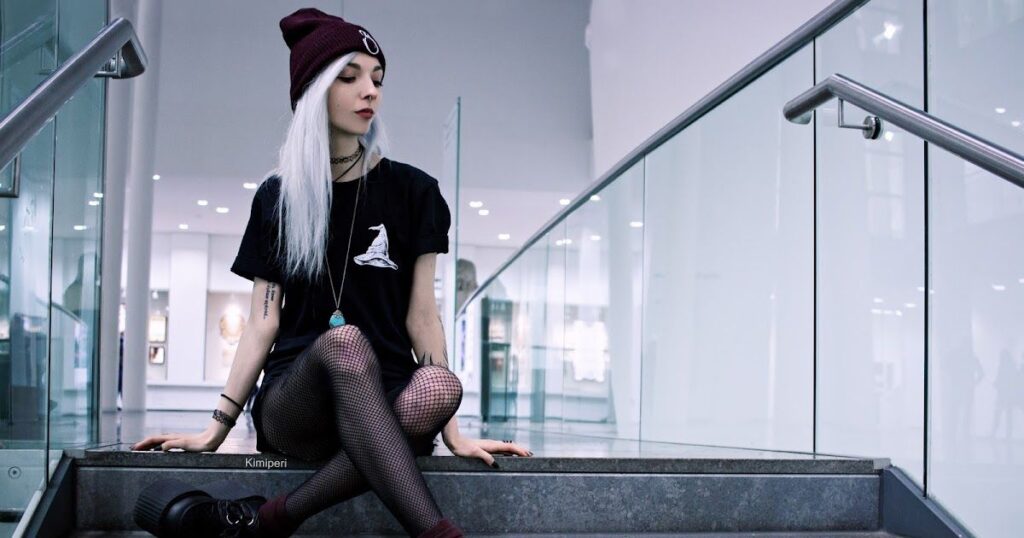
Nu goth, also referred to as hipster goth or modern goth, emerges as a fresh facet within the goth subculture, blending traditional elements with contemporary nuances. These individuals offer a novel take on gothic culture, amalgamating classical gothic motifs with modern sensibilities.
Their focus primarily lies on fashion, overshadowing music and ideology to some extent. While reminiscent of classic gothic aesthetics, nu goth is sometimes perceived as a diluted version of the traditional look. Despite its fusion with hipster influences, nu goth remains rooted in the foundational principles of gothic styles, maintaining its essence amidst evolving trends.
3. Romantic Goth
In the vast expanse of the goth community, there exists a captivating subculture known as Romantic Goth, where an emphasis is placed on sophistication, elegance, and an ethereal allure.
Romantic Goth style embodies a nostalgic charm, drawing inspiration from the romanticized era of Victorian fashion. Flowing gowns, cinched corsets, delicate lace, and subtle feminine accents dominate this aesthetic, typically swathed in darker hues of black.
Read this Post: Emily Ratajkowski Wiki Biography
Completing the enigmatic visage are dramatic makeup choices and elaborate hairstyles, ranging from loose curls to intricate braids or extravagant coiffures. Accessories play a crucial role, often featuring intricate details such as embroidery, beading, and delicate lacework.
Beyond mere fashion, the Romantic Goth subculture delves deeper into the realm of emotions, individuality, and a reverence for the natural world. Art, poetry, and literature are cherished, with romantic writers like Lord Byron, Mary Shelley, and William Wordsworth holding a special place in their hearts.
In the realm of music, Romantic Goths gravitate towards gothic and darkwave bands that resonate with their penchant for melodic and romantic sounds. This preference serves as a stark contrast to the darker and more aggressive themes prevalent in other goth styles.
Within the Romantic Goth subculture, beauty, romanticism, and personal expression reign supreme, offering a unique and enchanting perspective that sets them apart from their peers.
4. Emo Goth
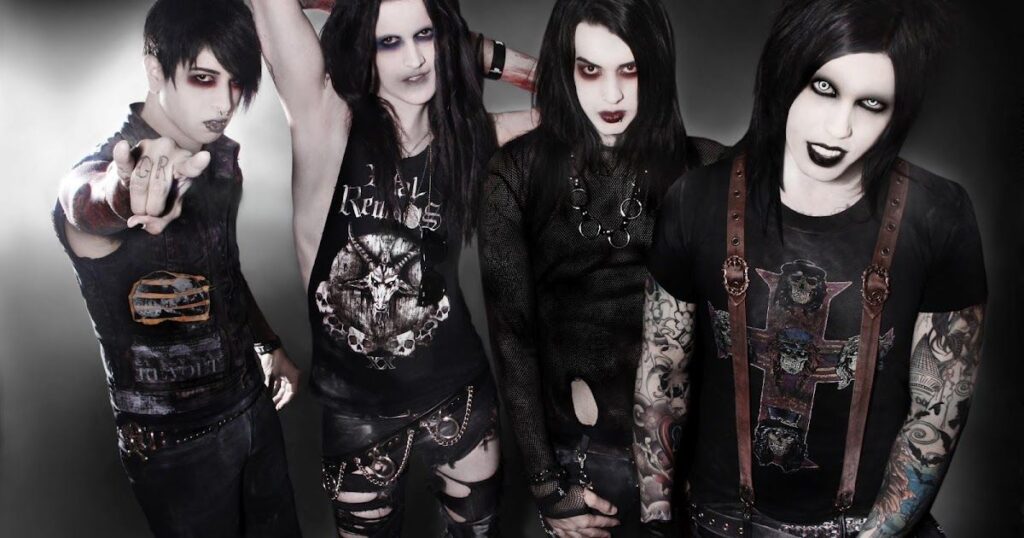
While some persist in classifying emo within the goth subculture framework, many regard it more as a distant relative to various gothic styles rather than an intricately connected subculture. Emerging in the late 1990s and early 2000s, emo garnered significant traction, even permeating into mainstream culture. However, as the 2010s unfolded, the once flourishing emo community dwindled in size, although remnants of emo goths still persist.
Despite its initial ties to classic gothic concepts, emo has matured into a distinct subculture. Emphasizing the significance of poetry and the celebration of emotions, it resonated deeply with teenagers, offering solace to those who felt marginalized by their intense feelings.
The music scene played a pivotal role in fostering this sense of belonging, with bands like Taking Back Sunday, Funeral for a Friend, Secondhand Serenade, Senses Fail, Underoath, The Used, and others providing a soundtrack for emo goths.
Characteristic of hardcore emo music was the inclusion of screaming, often accompanying poignant lyrical passages. Emo fashion further distinguished itself, featuring tight, narrow jeans, band t-shirts, Vans or Converse shoes, studded belts and bracelets, piercings, tattoos, and notably, hairstyles often adorned with long bangs. This distinct aesthetic has solidified emo as one of the most recognizable variations within the broader spectrum of gothic styles.
5. Medieval Goth
Embrace the allure of the medieval gothic style, where a captivating blend of somber, contemplative aesthetics meets echoes of bygone eras.
Crafted from rich, textured fabrics such as velvet, lace, and leather, garments in this style exude an air of mystery and elegance. Think corsets, tunics, capes, and flowing gowns reminiscent of ancient times.
Accessories play a crucial role, with chokers, crowns, and opulent jewelry adding a regal touch to the ensemble. Elaborate headpieces further enhance the allure, transporting wearers to a realm of enchantment.
Immerse yourself in a world of darkness and romance, where themes of vampires, witches, and medieval lore reign supreme. Drawing inspiration from Victorian and Edwardian influences, this fashion seamlessly melds historical elements with a touch of the macabre.
6. Bubble Goth

Kerli Koiv, an Estonian pop sensation, stands as the visionary behind the captivating emergence of “bubble goth,” a modern twist on the gothic style. With a desire to blend the eerie with the exquisite, Koiv set out to redefine conventional aesthetics, infusing them with a unique charm. Much like the goth movement itself, bubble goth thrives on innovation and individuality.
Koiv’s influence extends beyond mere fashion; it permeates the very essence of the music genre associated with bubble goth. Fusing pop melodies with darker electronic undertones, this genre offers a fresh take on the gothic sound, distinguishing itself from its cyber goth predecessors. The symbiotic relationship between music and style is unmistakable, with Koiv’s creations serving as the cornerstone for both.
Drawing inspiration from various gothic subcultures, bubble goth incorporates elements reminiscent of cyber goth fashion, such as gas masks and futuristic accessories. Yet, it also shares similarities with pastel goth, opting for a lighter color palette to counterbalance the traditionally somber tones. Through a fusion of styles, bubble goth breathes new life into the gothic aesthetic, celebrating diversity and expression in equal measure.
7. Hippie Goth
The captivating blend of the free-spirited ethos of hippies and the enigmatic allure of goths has birthed a mesmerizing fusion known as the hippie goth look. This distinct aesthetic harmonizes the flowing, bohemian essence of hippie attire with the darker undertones of black lace, leather, and studs.
Central to mastering the Hippie Goth style is the delicate equilibrium between light and shadow, crafting an edgy yet ethereal visage. The true essence lies in embracing one’s individuality, allowing the imagination to soar freely. Experimentation with textures, hues, and motifs is encouraged to forge a truly original expression.
Accessories play a pivotal role in amplifying the Hippie Goth vibe, with bold sunglasses, chunky jewelry, and wide-brimmed hats serving as indispensable accoutrements. Whether immersing oneself in the pulsating ambiance of a music festival or simply tackling daily errands, the hippie-goth look provides a canvas for showcasing one’s rebellious spirit and distinctive flair.
Further personalization can be achieved through the addition of embroidered patches, offering a versatile avenue for embellishing garments. Customizing these patches infuses an extra layer of style and sophistication, elevating the overall aesthetic and ensuring a unique sartorial statement.
8. Vampire Goth
Much like romantic goths, who embrace Victorian fashion elements, the vampire goth aesthetic also exudes an aristocratic allure.
At the core of vampire goth culture lies a profound fascination with all things vampiric, echoing the allure of nocturnal beings and Gothic literature. This fascination traces its roots back to the early works of authors such as Anne Rice.
The attire of vampire goths often features a striking blend of fangs, luxurious satin and silk garments, elegant robes, and opulent gowns, reflecting a refined taste for the finer things in life.
For some, the immersion in vampire culture goes beyond mere fashion; it becomes a lifestyle. These individuals, often referred to as part of the “Vampyre” subculture, adopt the beliefs and behaviors associated with vampires, embracing notions of energy exchange and even blood consumption as more than just fictional fantasies.
9. Casual Goth

Among the freshest iterations within goth fashion is the emergence of casual goth. Enthusiasts delight in blending eerie and ominous elements with everyday, laid-back clothing choices.
Predominantly, casual goths gravitate towards the timeless allure of black, frequently adorning themselves in black shirts and jeans.
Their signature look features long, straight hair complemented by a singular cosmetic choice: black lipstick.
To fully embody their aesthetic, they accessorize with unconventional jewelry, adorning their hands, limbs, noses, ears, and necks.
10. Bohemian Goth
Discover the enigmatic fusion of two distinct cultures in the captivating realm of “Bohemian Goth”. This emerging subculture seamlessly intertwines the haunting allure of gothic aesthetics with the free-spirited essence of bohemian attire.
Adorning oneself in a palette of dark, earthy tones such as black, brown, and deep reds, Bohemian Goths exude an ethereal charm. Their wardrobe is an eclectic mix of flowing, loose-fitting garments crafted from natural materials, echoing the bohemian ethos.
Long scarves, leather boots, and striking jewelry fashioned from feathers, stones, and crystals adorn their enigmatic ensembles. Whether it’s long skirts, layered shirts, or flowing blouses, Bohemian Goths embrace a style that celebrates individuality and creativity.
In the realm of cosmetics and hairstyles, the fusion continues. Natural-looking makeup accentuates bold lip colors and smokey eyes, mirroring the mysterious allure of the gothic aesthetic. Their hair, left to cascade in natural braids or waves, adds a whimsical touch to their captivating presence. Embrace the enchanting synthesis of bohemian freedom and gothic allure with the mesmerizing style of Bohemian Goth.
11. Cyber Goth
In the late 1990s and early 2000s, a vibrant subculture emerged, known as Cyber Goths. This distinctive group seamlessly melds the edgy elements of cyberpunk with the pulsating energy of rave culture and the dark allure of goth fashion. Their aesthetic is a symphony of neon hues, PVC, vinyl, and latex, creating an otherworldly appearance that is both captivating and enigmatic.
At the heart of their style lies their hair, which is meticulously crafted into intricate designs featuring dreadlocks, cyber lox, and synthetic extensions, evoking a futuristic, almost cyborg-like allure. Adorned with LED lights, goggles, and industrial-themed accessories like gas masks, they project an image of techno-savvy rebels.
Cyber Goths are devout disciples of electronic music, particularly trance, industrial, and electronic beat music (EBM). They congregate at bars and concerts that pulsate with the sounds of rave and industrial music, forming a tight-knit community fueled by their shared passion.
Their influence extends beyond mere fashion and music; Cyber Goths have pioneered new forms of dance, such as “cyber-dancing,” a fusion of industrial and rave movements that electrifies dance floors worldwide. Their subculture is a testament to their unique style, unwavering devotion to electronic beats, and celebration of technology, dance, and individualism.
12. Deathrocker Goth
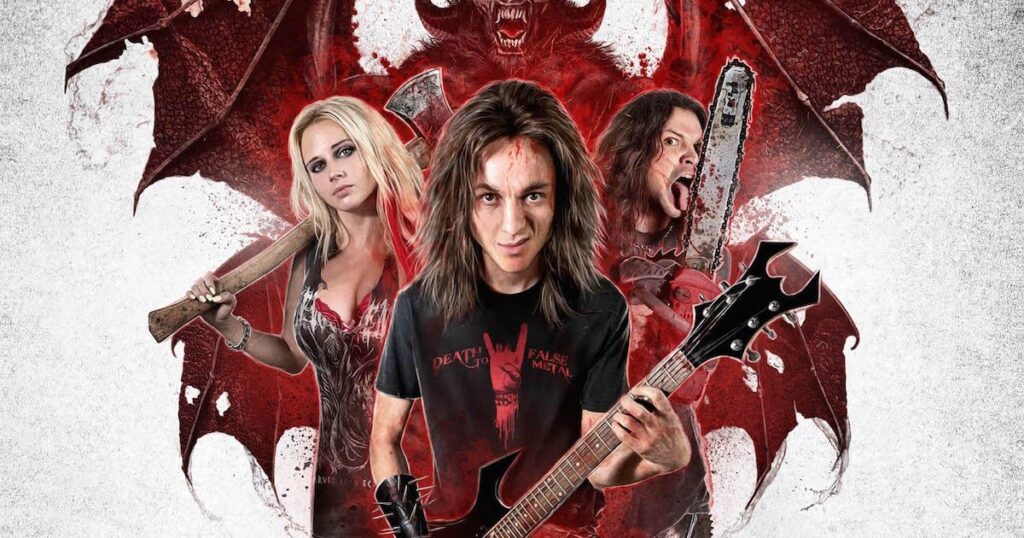
Deathrocker Goths represent a distinctive fusion of gothic and punk influences, emerging as a significant subset within the diverse tapestry of gothic culture. Positioned at the nexus of punk’s rebellious ethos and the dark allure of traditional goth aesthetics, Deathrockers carve out their unique identity.
With roots deeply embedded in punk origins, Deathrockers traverse a stylistic landscape that exists between the realms of classic goth and punk subcultures. They embody a darker manifestation of punk sensibilities, amplifying traditional gothic elements to forge a compelling alternative look.
Drawing inspiration primarily from the edgy realm of punk fashion, Deathrockers transcend mere imitation by infusing their style with distinctly gothic accents. This innovative approach cements their status as the bridge between goth and punk, embodying a synthesis that resonates with both communities.
Visually striking, the hallmark of Deathrocker attire lies in its fusion of quintessential punk elements—think rugged jeans, chains, piercings, and bold makeup—imbued with a hauntingly gothic undertone. This synthesis yields a captivating aesthetic that captivates the imagination and stands as a testament to the boundless creativity within gothic culture.
13. Perky Goth
Perky Goth stands as a pinnacle within the goth styles, radiating boundless energy and enthusiasm akin to the Energizer Bunny on a surge of steroids. Unlike their counterparts adhering to the dark and gloomy stereotypes, Perky Goths embrace life with an unwavering zest.
Their approach to goth culture is refreshingly vibrant, eschewing the somber demeanor for a more lively and spirited outlook. Instead of dwelling in shadows, they find joy in the brighter facets of the subculture, reveling in the excitement of Halloween and the nostalgic charm of the 1980s.
For Perky Goths, being part of the goth scene is synonymous with enjoyment; they thrive on the upbeat elements, frequently engaging in lively dancing and social gatherings. Their vivacious presence infuses every occasion with a sense of exuberance, making them a cherished asset to the goth community.
14. Victorian Goth
As the moniker suggests, Victorian Goths draw significant influence from the opulent Victorian era, renowned for its lavish attire and refined grooming.
Emulating the affluent Victorian aristocracy, these Goths epitomize a penchant for life’s finer offerings.
Their social calendar is punctuated with formal gatherings and grandiose affairs, reflecting their admiration for Victorian poetry, literature, and pastimes.
This subsect of Goth culture amalgamates the gloomy aesthetic with a sense of upper-class refinement.
Musically, Victorian Goth compositions echo classical motifs, often intertwined with a shared adoration for opera and theatrical spectacles.
Distinctive hallmarks of this style include extravagant ballgowns, tightly-laced corsets, ornate headwear, elbow-length gloves, and intricate jewelry, such as chokers and necklaces.
Physical appearances commonly feature long, ebony locks, a pallid complexion, and understated makeup, completing the quintessence of Victorian elegance.
15. Traditional Goth
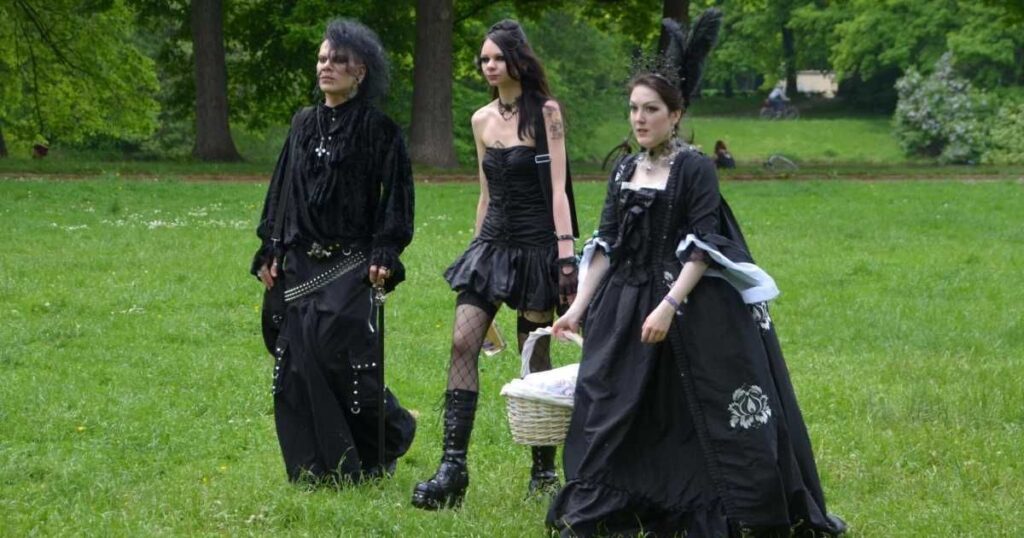
The term “Traditional Goth” or “Old-School Goth” refers to the pioneering phase of the gothic subculture, originating in the UK during the late 1970s and early 1980s.
Drawing inspiration from horror movies, literature, and music, this early movement left an enduring mark on gothic culture.
Characteristic of traditional goth music is its haunting, melancholic tones, often featuring extensive use of synthesizers and drum machines.
Similarly, traditional goth fashion predominantly revolves around black attire, incorporating romantic and Victorian elements such as ruffled dresses, corsets, flowing gowns, lace, leather, and copious amounts of black makeup.
Enthusiasts of this subculture typically share interests in poetry, art, literature, and music, with a penchant for works by luminaries like H.P. Lovecraft, Anne Rice, and Edgar Allan Poe.
They also engage in philosophical discourse on existential topics such as the meaning of life, death, and the afterlife.
Despite its evolution over time, the classic goth scene remains a prominent and enduring style within the broader gothic community, characterized by its distinctive blend of music, fashion, and cultural identity.
16. Pastel Goth
Introducing a captivating fashion phenomenon known as pastel goth, which made its stylish debut in the early 2010s. This trend ingeniously marries the ethereal allure of pastel hues with the edgy essence of gothic and kawaii influences. Picture delicate shades of pink, lavender, mint green, and baby blue harmonizing seamlessly with dark and daring elements such as spikes, crosses, and skulls.
Rooted in the depths of the gothic subculture, pastel goth takes a delightful spin by infusing it with a whimsical touch. Enthusiasts of this trend opt for a lighter, more wearable palette, all while maintaining the mysterious allure of the traditional gothic aesthetic.
The wardrobe of a pastel goth aficionado boasts a diverse array of clothing options, ranging from skirts and dresses to leggings and crop tops. Complementing these chic ensembles are accessories that truly make a statement, including platform shoes, oversized bows, and iconic chokers.
But the enchantment doesn’t stop there; many devotees of pastel goth fashion embrace the trend with vibrant pastel-colored hair, often in shades of pink, lavender, or blue. In essence, pastel goth isn’t just a fashion choice; it’s a captivating fusion of light and darkness, creating a unique and enchanting style landscape.
17. Steampunk Goth
In the intriguing realm of fashion subcultures lies the captivating fusion known as “steampunk goth.” This distinctive blend seamlessly intertwines elements of science fiction and fantasy with the elegance and allure of the Victorian era.
At its core, the essence of steampunk goth celebrates individuality, resourcefulness, and a flair for the unconventional. Enthusiasts of this style often don Victorian-inspired garments imbued with a tantalizing twist of futuristic aesthetics, epitomized by the likes of corsets paired with top hats.
Yet, it’s not merely about attire; it’s a testament to a lifestyle governed by innovation, boundless imagination, and the relentless pursuit of creativity. Adherents of steampunk goth take pride in their do-it-yourself ethos, fashioning bespoke apparel and accessories that reflect their unique personalities. Their color palette, predominantly adorned with hues of browns, blacks, and brass accents, serves as a nod to the rich tapestry of the Victorian era.
But steampunk goth transcends mere fashion trends; it’s a vibrant tapestry woven with threads of history and fantasy. From fantastical airships to intricate mechanical clockwork, this subculture embraces the fantastical realms of science fiction with open arms.
Above all, steampunk goths champion the cultivation of individual interests and unconventional modes of self-expression. It’s a sanctuary where the peculiar and the extraordinary are not only accepted but celebrated.
In essence, steampunk goth emerges as an unconventional yet enchanting subculture, offering a haven for those who dare to defy convention and forge their own path through the annals of history and fantasy.

Hey there! I have 5 years of experienced Familynexa Bringing families closer together through shared experiences, advice, and memories. Building connections that last lifetimes.
